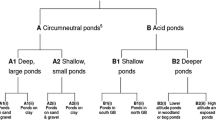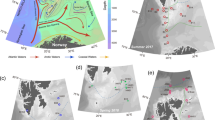Abstract
The seasonal dynamics of Daphnia populations vary regionally throughout the United States. Within the general pattern, Daphnia increase in abundance after the initiation of the spring algal bloom in all lakes, but their subsequent seasonal patterns differ in various climatic regions. Lakes in regions with cooler summers have large-bodied Daphnia populations that tend to persist throughout the summer, although the species dominance may shift. Regions with warmer summers tend to have large-bodied Daphnia populations that decline or are absent through much of the summer. Still warmer water bodies tend to have medium- to small-bodied species that are abundant during spring, but absent most of the summer. Many central Florida lakes lack Daphnia; if Daphnia species are present, they tend to be small-bodied. Daphnia abundance in these water bodies varies, but seems to be independent of temperature.
If surface water (lake, pond) sampling is done in all regions during July and August, the impression will be that Daphnia are absent from large segments of the United States. This would be erroneous, because Daphnia are important earlier during the spring and early summer but are likely to be absent during midsummer in some U.S. regions. Year-to-year variation will be superimposed on this regional pattern. Because there are differences in the dates when spring and summer occur, it would be useful to have an index period that would standardize the start of the growing season. The use of the terrestrial onset of greenness, based on remote sensing of the Normalized Difference Vegetation Index, is suggested as a possible index set point.
Similar content being viewed by others
References
Balcer, M. D., Korda, N. L., and Dodson, S. I.: 1984, “Zooplankton of the Great Lakes: a guide to the identification and ecology of the common crustacean species,” University of Wisconsin.
Beaver, J. R., Crisman, T. L., and Bays, J.S.: 1981, “Thermal regimes of Florida Lakes: a comparison with biotic and climatic transitions,” Hydrobiologia 83, 267–273.
Birge, E. A.: 1897, “Plankton studies on Lake Mendota. II. The Crustacea of the plankton from July, 1894, to December, 1896,” Trans. Wisc. Acad. Sci. Arts Lett. 11, 274 247-448.
Brooks, J. L.: 1957, “The systematics of North American Daphnia: Memoirs of the Connecticut Academy of Arts and Sciences, 13,” Yale.
Fairchild, J. F., LaPoint, T. W., Zajicek, J. L., Nelson, M. K., Dwyer, F. J., and Lovely, P. A.: 1992, “Population-, community-and ecosystem-level responses of aquatic mesocosms to pulsed doses of a pyrethroid insecticide,” Environ. Toxicol. Chem. 11, 115–129.
Havens, K. E., and Hanazato, T.: 1993, “Zooplankton community responses to chemical stressors: a comparison of results from acidification and pesticide contamination research,” Environ. Pollut. 82, 277–288.
Lampert, W.: 1987, “Predictability in lake ecosystems: the role of biotic interactions,” in E.-D. Schulze and H. Zwolfer (eds): Ecological Studies 61, Springer-Verlag, Berlin, pp. 333–346.
Marmorck, D. R., and Korman, J.: 1993, “The use of zooplankton in a biomonitoring program to detect lake acidification and recovery,” Watter Soil Air Pollut. 69: 223–241.
Odum, E. P.: 1985, “Trends expected in stressed ecosystems,” BioScience 35, 419–422.
Threlkeld, S. T.: 1979, “The midsummer dynamics of two Daphnia species in Wintergreen Lake, Michigan,” Ecology 60, 165–179.
Threlkeld, S. T.: 1985, “Resource variation and the initiation of midsummer declines of cladoceran populations,” Arch. Hydrobiol. 21, 333–340.
Tieszen, L. L., Reed, B. C., Bliss, N. B., Wylie, B. K., and Dejong, D. D.: 1997, “NDVI, C3 and C4 production, and distributions in great plains grassland land cover classes,” Ecol. Appl. 7, 59–78.
Webber, E. C., Deutsch, W. G., Bayne, D. R., and Seesock, W. C.: 1992, “Ecosystem-Level testing of a synthetic pyrethroid insecticide in aquatic mesocosms,” Environ. Toxicol. Chem. 11, 87–105.
Wiseman, C. D.: 1996, “Seasonal dynamics of cladoceran zooplankton in water bodies of the conterminous United States: do regional patterns exist?” M.S. thesis, University of Washington, 118 pp.
Author information
Authors and Affiliations
Rights and permissions
About this article
Cite this article
Taub, F.B., Wiseman, C.D. Implications of Seasonal and Regional Abundance Patterns of Daphnia on Surface Water Monitoring and Assessment. Environ Monit Assess 51, 53–60 (1998). https://doi.org/10.1023/A:1005933824382
Issue Date:
DOI: https://doi.org/10.1023/A:1005933824382




